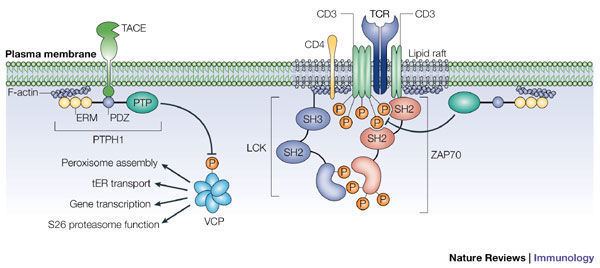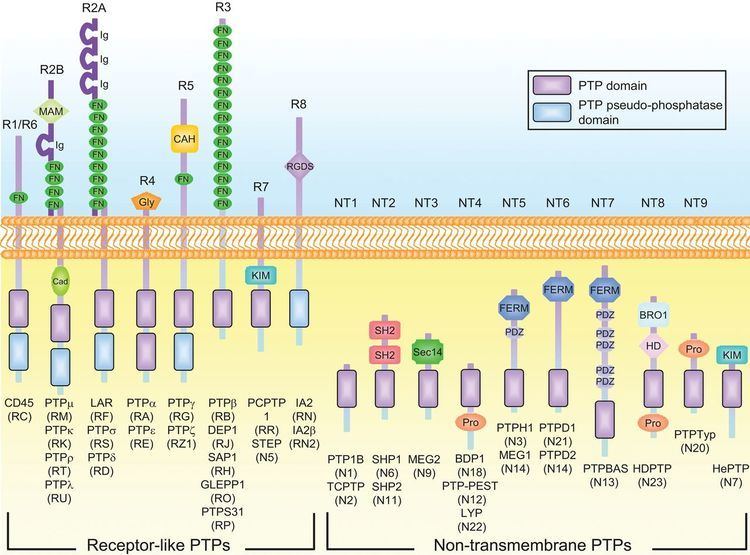EC number 3.1.3.48 ExPASy NiceZyme view | CAS number 79747-53-8 | |
Medical vocabulary what does sh2 domain containing protein tyrosine phosphatases mean
Protein tyrosine phosphatases are a group of enzymes that remove phosphate groups from phosphorylated tyrosine residues on proteins. Protein tyrosine (pTyr) phosphorylation is a common post-translational modification that can create novel recognition motifs for protein interactions and cellular localization, affect protein stability, and regulate enzyme activity. As a consequence, maintaining an appropriate level of protein tyrosine phosphorylation is essential for many cellular functions. Tyrosine-specific protein phosphatases (PTPase; EC 3.1.3.48) catalyse the removal of a phosphate group attached to a tyrosine residue, using a cysteinyl-phosphate enzyme intermediate. These enzymes are key regulatory components in signal transduction pathways (such as the MAP kinase pathway) and cell cycle control, and are important in the control of cell growth, proliferation, differentiation, transformation, and synaptic plasticity.
Contents
- Medical vocabulary what does sh2 domain containing protein tyrosine phosphatases mean
- Medical vocabulary what does protein tyrosine phosphatases mean
- Functions
- By mechanism
- Class I
- Class II
- Class III
- Class IV
- By location
- Common elements
- Expression pattern
- References

Medical vocabulary what does protein tyrosine phosphatases mean
Functions

Together with tyrosine kinases, PTPs regulate the phosphorylation state of many important signalling molecules, such as the MAP kinase family. PTPs are increasingly viewed as integral components of signal transduction cascades, despite less study and understanding compared to tyrosine kinases.
PTPs have been implicated in regulation of many cellular processes, including, but not limited to:
By mechanism
PTP activity can be found in four protein families.

Links to all 107 members of the protein tyrosine phosphatase family can be found in the template at the bottom of this article.
Class I
The class I PTPs, are the largest group of PTPs with 99 members, which can be further subdivided into
Dual-specificity phosphatases (dTyr and dSer/dThr) dual-specificity protein-tyrosine phosphatases. Ser/Thr and Tyr dual-specificity phosphatases are a group of enzymes with both Ser/Thr (EC 3.1.3.16) and tyrosine-specific protein phosphatase (EC 3.1.3.48) activity able to remove the serine/threonine or the tyrosine-bound phosphate group from a wide range of phosphoproteins, including a number of enzymes that have been phosphorylated under the action of a kinase. Dual-specificity protein phosphatases (DSPs) regulate mitogenic signal transduction and control the cell cycle.
LEOPARD syndrome, Noonan syndrome, and Metachondromatosis are associated with PTPN11.
Elevated levels of activated PTPN5 negatively affects synaptic stability and plays a role in Alzheimer’s disease, Fragile X Syndrome schizophrenia, and Parkinson’s disease. Decreased levels of PTPN5 has been implicated in Huntington's disease, cerebral ischemia alcohol abuse, and stress disorders. Together these findings indicate that only at optimal levels of PTPN5 is synaptic function unimpaired.
Class II
LMW (low-molecular-weight) phosphatases, or acid phosphatases, act on tyrosine phosphorylated proteins, low-MW aryl phosphates and natural and synthetic acyl phosphates.
The class II PTPs contain only one member, low-molecular-weight phosphotyrosine phosphatase (LMPTP).
Class III
Cdc25 phosphatases (dTyr and/or dThr)
The Class III PTPs contains three members, CDC25 A, B, and C
Class IV
pTyr-specific phosphatases
The class IV PTPs contains four members, Eya1-4.
This class is believed to have evolved separately from the other three.
By location
Based on their cellular localization, PTPases are also classified as:
Common elements
All PTPases, other than those of the eya family, carry the highly conserved active site motif C(X)5R (PTP signature motif), employ a common catalytic mechanism, and possess a similar core structure made of a central parallel beta-sheet with flanking alpha-helices containing a beta-loop-alpha-loop that encompasses the PTP signature motif. Functional diversity between PTPases is endowed by regulatory domains and subunits.
Expression pattern
Individual PTPs may be expressed by all cell types, or their expression may be strictly tissue-specific. Most cells express 30% to 60% of all the PTPs, however hematopoietic and neuronal cells express a higher number of PTPs in comparison to other cell types. T cells and B cells of hematopoietic origin express around 60 to 70 different PTPs. The expression of several PTPS is restricted to hematopoietic cells, for example, LYP, SHP1, CD45, and HePTP. The expression of PTPN5 is restricted to the brain. Differential expression of PTPN5 is found in many brain regions, with no expression in the cerebellum.
